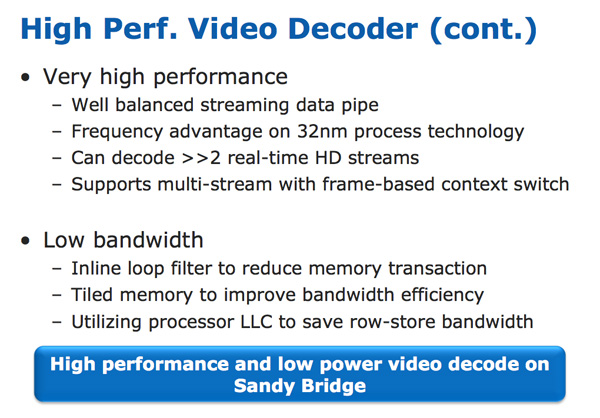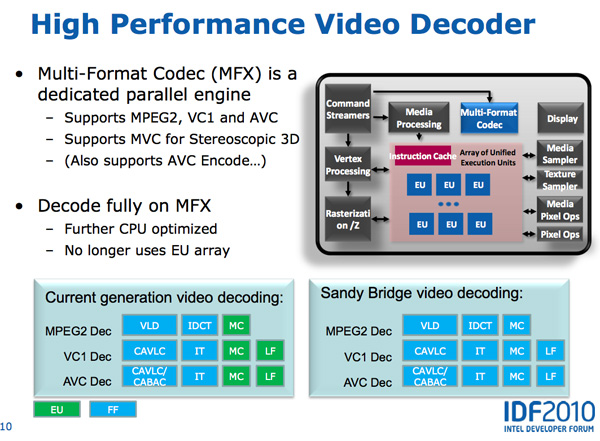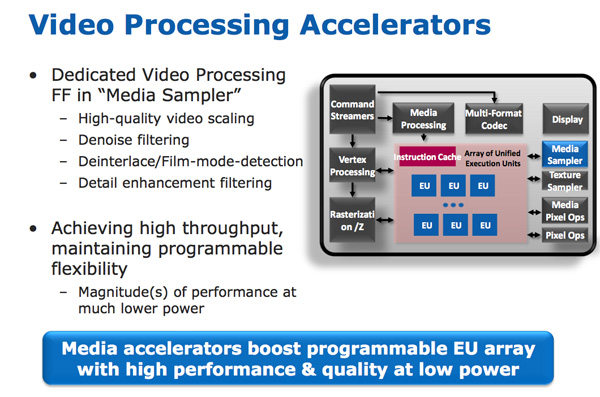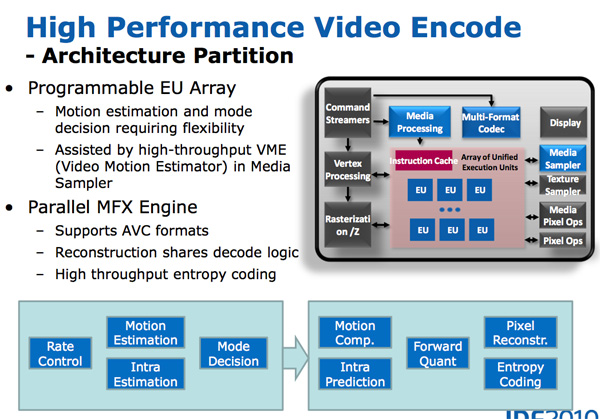The Sandy Bridge Review: Intel Core i7-2600K, i5-2500K and Core i3-2100 Tested
by Anand Lal Shimpi on January 3, 2011 12:01 AM ESTIntel’s Quick Sync Technology
In recent years video transcoding has become one of the most widespread consumers of CPU power. The popularity of YouTube alone has turned nearly everyone with a webcam into a producer, and every PC into a video editing station. The mobile revolution hasn’t slowed things down either. No smartphone can play full bitrate/resolution 1080p content from a Blu-ray disc, so if you want to carry your best quality movies and TV shows with you, you’ll have to transcode to a more compressed format. The same goes for the new wave of tablets.
At a high level, video transcoding involves taking a compressed video stream and further compressing it to better match the storage and decoding abilities of a target device. The reason this is transcoding and not encoding is because the source format is almost always already encoded in some sort of a compressed format. The most common, these days, being H.264/AVC.
Transcoding is a particularly CPU intensive task because of the three dimensional nature of the compression. Each individual frame within a video can be compressed; however, since sequential frames of video typically have many of the same elements, video compression algorithms look at data that’s repeated temporally as well as spatially.
I remember sitting in a hotel room in Times Square while Godfrey Cheng and Matthew Witheiler of ATI explained to me the challenges of decoding HD-DVD and Blu-ray content. ATI was about to unveil hardware acceleration for some of the stages of the H.264 decoding pipeline. Full hardware decode acceleration wouldn’t come for another year at that point.
The advent of fixed function video decode in modern GPUs is important because it helped enable GPU accelerated transcoding. The first step of the video transcode process is to first decode the source video. Since transcoding involves taking a video already in a compressed format and encoding it in a new format, hardware accelerated video decode is key. How fast a decode engine is has a tremendous impact on how fast a hardware accelerated video encode can run. This is true for two reasons.
First, unlike in a playback scenario where you only need to decode faster than the frame rate of the video, when transcoding the video decode engine can run as fast as possible. The faster frames can be decoded, the faster they can be fed to the transcode engine. The second and less obvious point is that some of the hardware you need to accelerate video encoding is already present in a video decode engine (e.g. iDCT/DCT hardware).
With video transcoding as a feature of Sandy Bridge’s GPU, Intel beefed up the video decode engine from what it had in Clarkdale. In the first generation Core series processors, video decode acceleration was split between fixed function decode hardware and the GPU’s EU array. With Sandy Bridge and the second generation Core CPUs, video decoding is done entirely in fixed function hardware. This is not ideal from a flexibility standpoint (e.g. newer video codecs can’t be fully hardware accelerated on existing hardware), but it is the most efficient method to build a video decoder from a power and performance standpoint. Both AMD and NVIDIA have fixed function video decode hardware in their GPUs now; neither rely on the shader cores to accelerate video decode.
The resulting hardware is both performance and power efficient. To test the performance of the decode engine I launched multiple instances of a 15Mbps 1080p high profile H.264 video running at 23.976 fps. I kept launching instances of the video until the system could no longer maintain full frame rate in all of the simultaneous streams. The graph below shows the maximum number of streams I could run in parallel:
| Intel Core i5-2500K | NVIDIA GeForce GTX 460 | AMD Radeon HD 6870 | |
| Number of Parallel 1080p HP Streams | 5 streams | 3 streams | 1 stream |
AMD’s Radeon HD 6000 series GPUs can only manage a single high profile, 1080p H.264 stream, which is perfectly sufficient for video playback. NVIDIA’s GeForce GTX 460 does much better; it could handle three simultaneous streams. Sandy Bridge however takes the cake as a single Core i5-2500K can decode five streams in tandem.

The Sandy Bridge decoder is likely helped by the very large (and high bandwidth) L3 cache connected to it. This is the first advantage Intel has in what it calls its Quick Sync technology: a very fast decode engine.
The decode engine is also reused during the actual encode phase. Once frames of the source video are decoded, they are actually fed to the programmable EU array to be split apart and prepared for transcoding. The data in each frame is transformed from the spatial domain (location of each pixel) to the frequency domain (how often pixels of a certain color appear); this is done by the use of a discrete cosine transform. You may remember that inverse discrete cosine transform hardware is necessary to decode video; well, that same hardware is useful in the domain transform needed when transcoding.
Motion search, the most compute intensive part of the transcode process, is done in the EU array. It's the combination of the fast decoder, the EU array, and fixed function hardware that make up Intel's Quick Sync engine.













283 Comments
View All Comments
krazyderek - Monday, January 3, 2011 - link
putting the 3000 on the the 2600k and 2500k parts ALMOST made sense as an up-sell, but you can't even use their IGP when on a P series board when you're overclocking! If the Z series wont' be out for a while why the hell would i buy an overclocking chip now? so i can spend more money to replace my H series motherboard with a Z series? Nice try.It's frustrating that you have to pick your sacrifice.... you either get the 3000 with the K sku, or you get VT-d and TXT with the standard sku. Intel doesn't have an offering with both which is kind of ridiculous for high end chips.
mino - Wednesday, January 5, 2011 - link
Yeah, what is most disappointing is lack of Virtualization support even from i3's (!)For christ's sake, Virtualization is the most BASIC requirement for any box today and even s775 Pentium, not to mention the WHOLE AMD lineup have it!
For me this means nothing sub-i5 is useable in ANY capacity, business or private while i5 are (financially) and overkill for most uses.
Well done Intel. You have just lost ~100 $100 certain sales this year. Whatever, will have to wait for Llano for the mainstream stuff.
DrSlothy - Wednesday, January 12, 2011 - link
I think that's an error in the review table, though one I've seen in every Core review so far - did Intel marketing give out wrong specs?Intel website shows the entire Sandy Bridge line-up to have Hardware Virtualisation (VT-x) support, though some are missing VT-d
tech6 - Monday, January 3, 2011 - link
Another great review from Anandtech - thanks guys.It seems odd that the 3000 series graphics engine would be only included on a part designed for over clocking and the boards that support overclocking can't handle integrated graphics. I would have thought that the other way around would have made more sense.
In any case the 2600K and 2500K look like great value parts and are just what I was waiting for!
DanNeely - Monday, January 3, 2011 - link
Does anyone know if QuickSync will appear on LGA-2011 chips? I know they aren't going to have the general purpose GPU components, but this is enough of a performance booster that I'd think Intel would want to keep it on their high end consumer platform in some fashion.ThaHeretic - Monday, January 3, 2011 - link
I see TXT in the last chart above with no explanation as to what it is or why it is differentiated. They -took out- functionality from the unlocked parts? That seems backwards...Kevin G - Monday, January 3, 2011 - link
This functionality will likely appear in Sandybridge Xeons for socket 1155. Intel *generally* segments the Xeons by core count and clock speed, not by feature set like they do for consumer chips. The other feature Intel is holding back is ECC which should be standard in socket 1155 Xeons.DanNeely - Monday, January 3, 2011 - link
It's a hardware security feature. It's best known for the Trusted Platform Module; an on board cryptographic device used in some corporate computers but not used in consumer systems. Probably they just want to keep people from building high end secure servers with cheap, overclocked K parts instead of the much more profitable XEONs for 2-3x as much.http://en.wikipedia.org/wiki/Trusted_Execution_Tec...
kache - Monday, January 3, 2011 - link
I think I'll wait for the SB xeons and the new EVGA SR-2, hoping that EVGA will release it.adrien - Monday, January 3, 2011 - link
Numbers will probably speak by themselves. ;-)17:37 ~ % md5sum *.png
bee3c83b3ef49504e0608a601a03bfc2 6870.png
bee3c83b3ef49504e0608a601a03bfc2 snb.png
So the 6870 and cpu-rendering have the same image.